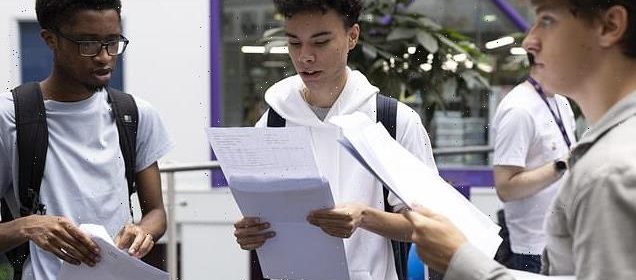Female pupils' lead in top grades narrows as lads do better in exams

Look out girls, the boys are catching up! Female pupils’ lead in A and A* grades narrows as ‘lazy’ lads do better in exams, experts say
- The gap between girls and boys in A and A* grades has narrowed to 2.2 points
- Yesterday 37.4 per cent of girls got an A, compared to 35.2 per cent of the boys
- Exam board chiefs said boys may have performed worse relatively during the pandemic because they are better suited to formal testing
Boys are starting to catch up with girls when it comes to the top A-level grades thanks to the return of exams and – according to experts – being ‘lazy’ last-minute crammers.
The lead by girls in A and A* grades has narrowed from 4.8 percentage points last year to 2.2 points this year, yesterday’s data showed.
It coincides with the return of exams for the first time since before the pandemic, as all tests in 2020 and 2021 had to be cancelled.
Instead, teachers decided pupils’ grades based on coursework and performance in online classes – and girls’ grades rocketed.
Students receive their A-level exam results after the lead by girls in A and A* grades narrowed to 2.2 points this year
Chris McGovern, a former boys’ school head teacher, said yesterday: ‘Exams do tend to benefit boys.
‘We cannot generalise, but in my experience some boys can be a little bit lazy.
‘They are less capable of steady hard work over a period of two years, and prefer to just work hard at the end, having a shorter period when they can cram.
‘They tend to prefer a target-driven curriculum, and they prefer a sprint rather than a marathon.
‘Remember also that boys develop later than girls, physically and academically.
‘Girls are on average more conscientious at doing coursework over a long period of time.’
Last year, a record 46.9 per cent of girls achieved an A grade or higher, while for boys it was just 42.1 per cent.
WRITING ON WALL FOR ENGLISH LIT
English literature has fallen out of the top ten most popular A-level subjects for the first time.
The number of pupils taking the exam plunged by 9.4 per cent from 39,492 in 2021 to 35,791 this year.
Figures released yesterday showed the top five subjects remain unchanged – maths, psychology, biology, chemistry and history.
Professor Alan Smithers, director of the Centre for Education and Employment Research at Buckingham University, accused ministers of a ‘disastrous’ approach by discouraging subjects such as English literature in favour of those with more direct career paths.
A spokesman for the Department for Education said the Government had reformed GCSE and A-level in English language and literature ‘to better prepare pupils for further study and employment’.
That 4.8 percentage point gap was much higher than the 3.2 point gap the year before.
This year, 37.4 per cent of girls got at least an A, 2.2 percentage points higher than boys at 35.2 per cent.
At subject level, boys overtook girls in French this year, with 51.9 per cent getting at least an A, compared with 49.3 per cent for girls.
Last year 59.9 per cent of female entries got a top grade, compared with 59.2 per cent of boys.
The same happened in further maths, with 68.2 per cent of male entries on least an A, compared with 64.7 per cent for females.
Last year, 77 per cent of female entries and 74.3 per cent of boys got at least an A.
This year, across all subjects, boys have narrowed the gap in attaining an A*.
They are now only 0.4 points behind rather than 1.3 previously.
Exam board chiefs said last year that boys may have performed worse relatively during the pandemic because they are better suited to formal testing.
Some campaigners claimed teacher-assessed grades also favoured students who behaved well in class, creating a positive bias towards them.
Alan Smithers, professor of education at the University of Buckingham, said: ‘Boys are more likely to adopt a big bang approach.
‘They really don’t take the classes particularly seriously, until a few weeks before the exam’s held and then spend long hours swotting up.
They go into the exam and pour it all out.’ But he offered an explanation for why girls are still ahead despite the return to exams.
‘The exams this year are not as searching as they were pre-pandemic, because they have given out the topics for the questions in advance.
That plays to the girls’ strengths because they are more likely to conscientiously prepare for the exam, compared to boys who tend to learn everything at the last moment,’ he said.
Source: Read Full Article

